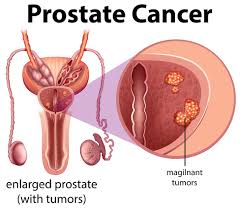
Prostate Cancer: Causes, Symptoms, and Treatment
Prostate cancer is one of the most common cancers in men, occurring when cells in the prostate gland grow uncontrollably. The prostate is a small gland located below the bladder and in front of the rectum, responsible for producing seminal fluid. Prostate cancer typically grows slowly, but some aggressive types can spread quickly.
Causes & Risk Factors
The exact cause of prostate cancer is unknown, but several risk factors increase the likelihood of developing the disease:
- Age – Risk increases significantly after 50 years.
- Family history – Having a father or brother with prostate cancer doubles the risk.
- Genetic mutations – BRCA1, BRCA2, and other inherited genes may contribute.
- Ethnicity – More common in African American men and less common in Asian men.
- Diet & lifestyle – High-fat diets, obesity, and lack of exercise may contribute.
- Hormonal factors – High testosterone levels may promote cancer cell growth.
Symptoms
In the early stages, prostate cancer may not cause noticeable symptoms. However, as the tumor grows, symptoms may include:
- Frequent urination, especially at night.
- Weak or interrupted urine flow.
- Difficulty starting or stopping urination.
- Blood in urine or semen.
- Erectile dysfunction (ED).
- Pain or discomfort in the pelvic area, lower back, or hips.
- Unexplained weight loss and fatigue (in advanced stages).
Diagnosis
Doctors use a combination of tests to diagnose prostate cancer:
- Prostate-Specific Antigen (PSA) Test – A blood test to measure PSA levels; high levels may indicate cancer.
- Digital Rectal Exam (DRE) – A doctor feels for abnormalities in the prostate.
- Prostate Biopsy – Tissue samples are taken to confirm cancer.
- Imaging Tests – MRI, CT scan, or bone scans check for cancer spread.
- Gleason Score & Staging – Determines how aggressive the cancer is and whether it has spread beyond the prostate.
Treatment Options
Treatment depends on the stage, aggressiveness, and patient’s overall health.
1. Active Surveillance (For Slow-Growing Cancer)
- Recommended for low-risk, slow-growing cancers.
- Regular PSA tests, DREs, and biopsies to monitor progression.
2. Surgery (Prostatectomy)
- Radical Prostatectomy – Complete removal of the prostate gland, often for localized cancer.
- Minimally invasive (robotic-assisted) surgery is also an option.
3. Radiation Therapy
- External Beam Radiation – High-energy rays target the prostate.
- Brachytherapy – Radioactive seeds implanted directly into the prostate.
4. Hormone Therapy (Androgen Deprivation Therapy, ADT)
- Lowers testosterone levels to slow cancer growth.
- Used in advanced cases or alongside radiation.
5. Chemotherapy
- Used for advanced or aggressive prostate cancer.
- Drugs like Docetaxel help slow tumor progression.
6. Immunotherapy & Targeted Therapy
- Sipuleucel-T (Provenge) – Boosts the immune system to fight cancer.
- PARP inhibitors for patients with genetic mutations (e.g., BRCA mutations).
7. Bone-Directed Therapy (For Metastatic Cancer)
- If cancer spreads to the bones, drugs like Bisphosphonates or Denosumab help manage bone loss and pain.
Complications & Side Effects of Treatment
- Urinary incontinence – Loss of bladder control.
- Erectile dysfunction – Common after surgery or radiation.
- Fatigue & hormonal changes – Due to hormone therapy.
- Bowel issues – Possible with radiation therapy.
Prognosis & Outlook
- Early-stage prostate cancer has a very high survival rate (nearly 100% at 5 years).
- Advanced-stage prostate cancer can be managed but is harder to cure.
- Regular monitoring and treatment advancements have significantly improved survival rates.
Would you like help with screening guidelines, dietary recommendations, or treatment side effect management?

